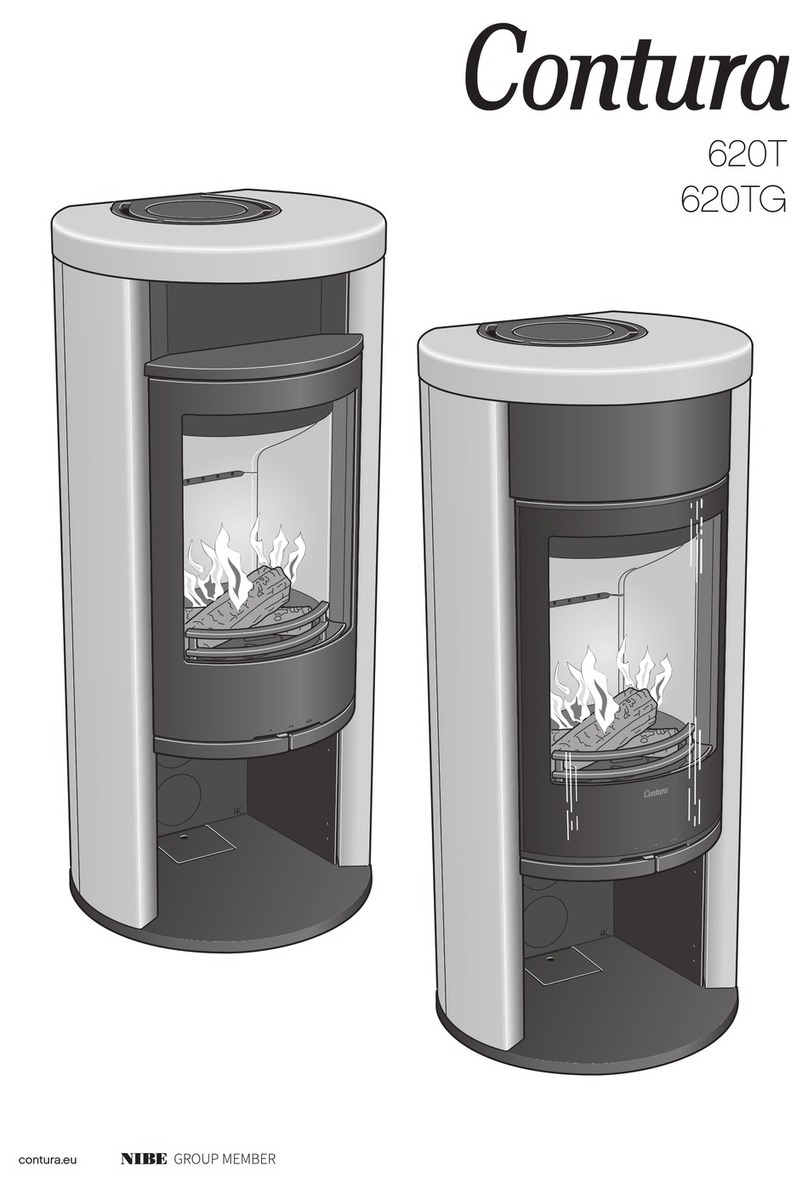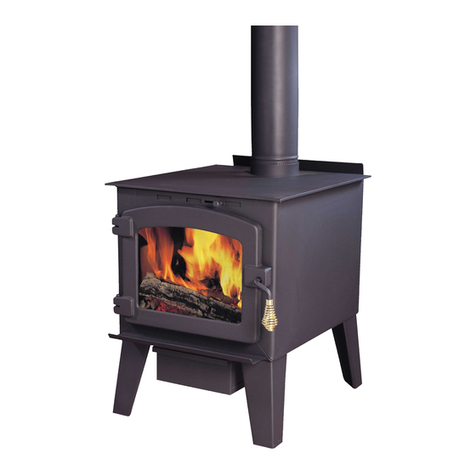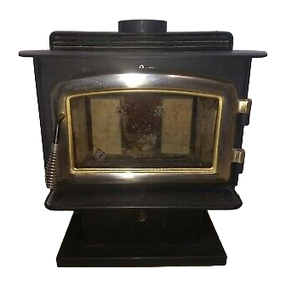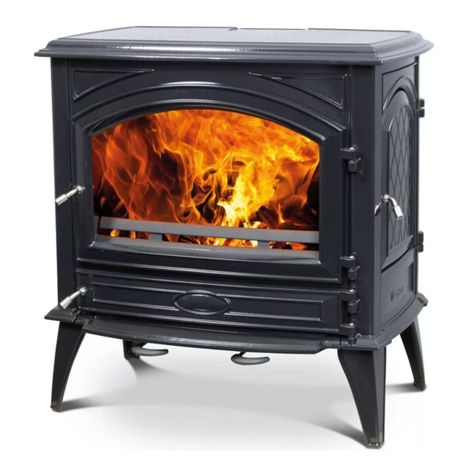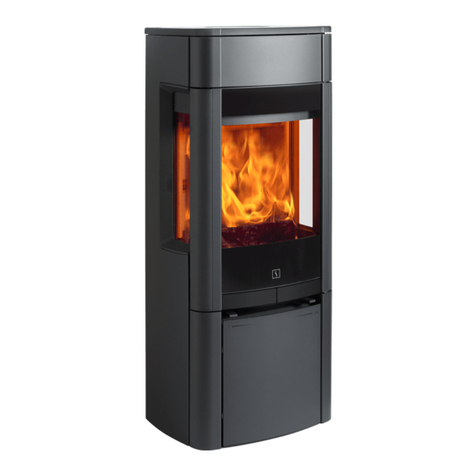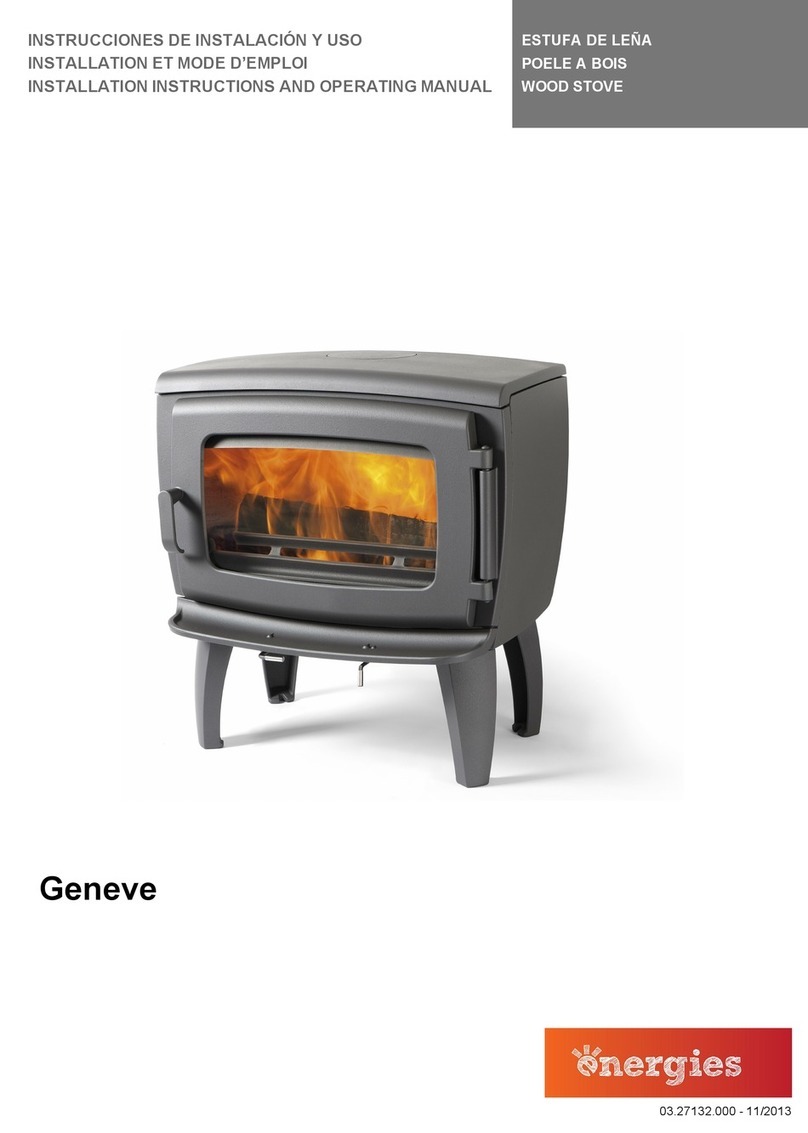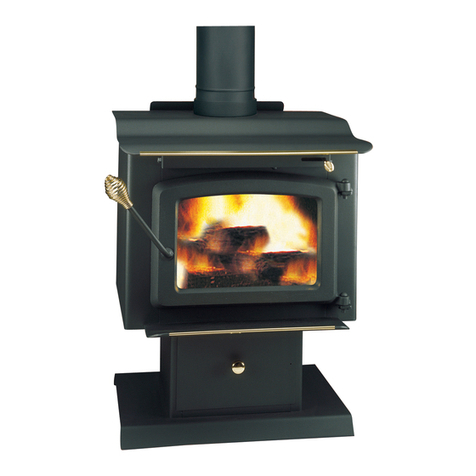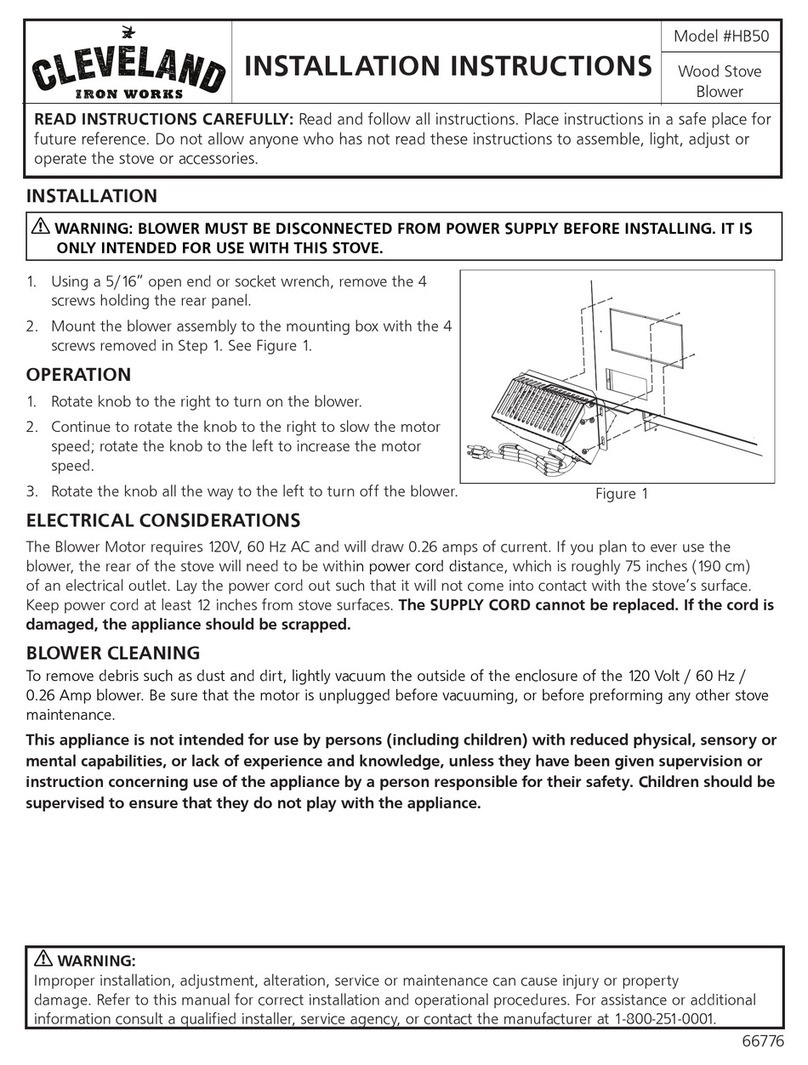WoodPro WS-TS-1500 User manual

www.woodprostoves.com 1-877-427-3316
WS-TS-1500
WS-TS-2000
WS-TS-2500
www.woodprostoves.com
www.woodprostoves.com
4085-112 Rev: C
This manual describes the installation and operation of the Brand
“WoodPRO” wood heater. This heater meets the 2015 U.S.
Environmental Protection Agency's crib wood emission limits for wood
heaters sold after May 15th 2015. Under specific test conditions this
heater has been shown to deliver heat at rates ranging from XXX to XXX Btu/hr.”
WS-TS-1500 : 10 650 to 27 350 btu/hr
WS-TS-2000 : 13 500 to 31 600 btu/hr
WS-TS-2500 : 13 000 to 30 800 btu/hr

1. The installation of this stove must comply with your
local building code rulings.Please observe the clear-
ances to combustibles (see reference figures 4–8).
Do not place fuel, furniture or any other objects within
the clearance area.
2. Verify that the stove is properly assembled and
installed before firing the stove for the first time.
After reading these instructions, if you have any
doubt about your ability to complete noitallatsniruoy
properly, you must obtain the services of a
professional licensed installer familiar with all
aspects of safe and correct installation. DO NOT
use temporar y or makeshi ft compromises
during installation. There must be NO DEVIATION
OR ALTERATION OF ANY KIND from the very spe-
cific instructions spelled out in this instruction manual
as it pertains to the installation of this woodstove.
NO EXCEPTIONS!
3. DO NOT store wood, kindling, flammable liquids
or other combustible materials in the vicinity of the
appliance. Refer to certification label on back of unit
and reference figures 4-8 in this manual.
4. FOR MOBILE HOME INSTALLATIONS IN U.S.A.
ONLY. DO NOT INSTALL IN MOBILE HOMES IN
CANADA. See additional mobile home require-
ments on page 11.
5. DO NOT ELEVATE THIS STOVE BY ANY MEANS.
(i.e. bricks under pedestal, cement blocks) Stove
pedestal must set directly upon the solid-surface non-
combustible floor as specified in this stove instruction
manual.
6. DO NOT MODIFY THIS STOVE IN ANY !YAW
Stove must be installed with pedestal and ash drawer
provided, attached as shown in the instructions.
DO NOT OPERATE WITHOUT ASH DRAWER
OR ASH CLEAN OUT COVER IN PLACE – NO
EXCEPTIONS. Assemble only with original parts as
supplied and shown in this manual. DO NOT OPER-
ATE A STOVE THAT IS MISSING ANY PARTS! If
any parts are missing or defective, please notify
the dealer or manufacturer immediately. Replace
missing, broken or worn parts with factory original
or equivalent parts only.
7. CAUTION: DO NOT ALTER COMBUSTION AIR
CONTROL RANGE TO INCREASE FIRING OR
FOR ANY REASON. Altering or tampering with air
control beyond normal capacity will create unsafe
and hazardous conditions.
8. Always connect this stove to a chimney and vent to
the outside. Never vent to a room or inside a building.
DO NOT CONNECT THIS UNIT TO A CHIMNEY
FLUE SERVING ANOTHER APPLIANCE.
9. DO NOT CONNECT A WOOD BURNING STOVE
TO AN ALUMINUM TYPE B GAS VENT. This is
not safe. Use code-approved masonry chimney
with flue liner or a manufactured Underwriters
Laboratories Listed UL 103 HT (US)/ULC-S629
(CAN) Residential Type and Building Heating Ap-
pliance Chimney. Use a 6˝/152mm diameter chim-
eeS(.tfarddoogaevigothguonehgihsitaht,yen
specifics in Chimney Connections instructions).
10. Be sure that your chimney is safely constructed and
in good repair. Have the chimney inspected by the fire
department or a qualified inspector. Your insurance
company should be able to recommend a qualified
inspector. Chimney connector pipe must be in good
condition. Replace if necessary before using stove.
11. Creosote or soot may build up in the chimney
connector and chimney and cause a house/building
fire. Inspect the chimney connector and chimney
twice monthly during the heating season and clean
if necessary. (see Service Hints).
12. In the event of a chimney fire, turn the air controls to
closed positions, leave the building and CALL THE
FIRE DEPARTMENT IMMEDIATELY! Have a clearly
understood plan on how to handle a chimney fire by
contacting your local fire authority for information
on proper procedures in the event of a chimney fir .e
After the fire is out, the chimney must be cleaned
and inspected for any stress or cracks before starting
another fire. Check the condition of any combustibles
surrounding the chimney.
13. Ashes should not be allowed to accumulate above
the top of the lower primary air orifice (LPAO, air vent
at front of firebox, just inside of door, at the center).
14. DISPOSAL OF ASHES
Ashes should be placed in a steel container with
a tight fitting lid and moved outdoors immediately.
The closed container of ashes should be placed
on a noncombustible floor or on the ground, well
away from all combustible materials, pending final
disposal. If the ashes are disposed of by burial in
soil or otherwise locally dispersed, they should be
retained in the closed container until all cinders have
completely cooled. Other waste shall not be placed
in this container.
15. To prevent injury, do not allow anyone use this stove
who is unfamiliar with the correct operation.
16. Do not operate stove while under the influence of
drugs or alcohol or lack of sleep.
17. DO NOT ELEVATE THE FIRE. Build fire directly on
the bottom of the firebox. This stove has not been
tested with the use of grates, andirons or other means
of elevating the fire and must not be used.
Page 2 WoodPRO™
SAFETY INSTRUCTIONS

SAFETY INSTRUCTIONS ...continued
WoodPRO™
/ Page 3
18. During the first 12 to 15 fires the special paints and pro-
tective oils used in construction of your stove may give
off some smoke and odor while they are curing. This
should disappear after a short period of time and not
occur again. Persons with lung conditions or own fosre
susceptible domestic pets (such as birds) should ta ek
prudent precautions. Open windows and doors as
needed to clear smoke and/or odor. Paint discolor-
ation will occur if the stove is over fired.
19. This stove has a painted surface which is durable
but it will not stand rough handling or abuse. When
installing your stove, use care in handling.
20. CLEAN STOVE FREQUENTLY as soot, creosote
and ash may accumulate. Clean exterior with soap
and warm water when stove is not hot. Do not use
any acids or scouring soap, as these solvents wear
and dull the finish.
21. ALERT ALL PERSONS TO THE HAZARDS OF
HIGH SURFACE TEMPERATURES while stove is
in operation – especially young children. Keep away
from a hot stove to avoid burns or clothing ignition.
22. NEVER LEAVE SMALL CHILDREN UNSUPER-
VISED WHEN THEY ARE IN THE SAME ROOM
AS THE STOVE. If small children will be in the same
room as the stove during operation, provide a sturdy
fire-proof barrier to keep them safe distance from the
stove.
23. Keep stove area clear and free from all combustible
materials, gasoline, engine oil, naphtha and other
flammable vapors and liquids.
24. WHILETENDING THE FIRE ALWAYS WEAR PRO-
TECTIVE CLOTHING, fire retardant hearth gloves
and eye protection, to prevent burns.
25. Never operate this stove without ash drawer, ash
clean out or with the door open except when re-
fueling. Such actions can result in very dangerous
operating conditions.
26. DO NOT OVER FIRE THE STOVE. Over firing
will occur if combustion air is uncontrolled as when
feed door is left open during operation. Such actions
can result in very dangerous operating conditions.
While in operation, keep the feed door closed and
secured at all times except while tending the fire
27. When adding fuel be careful not to smother the fire.
Do not build fires against glass and do not load fuel to
a height or in such a manner that it creates a hazard
when opening the door.
28. NEVER LEAVE THE STOVE UNATTENDED with
door open. Always close the door after ignition.
29. DO NOT CONNECT TO OR USE IN CONJUNC-
TIONWITH ANY AIR DISTRIBUTION DUCTWORK
UNLESS SPECIFICALLY APPROVED FOR SUCH
INSTALLATIONS.
30. A WOOD-BURNING STOVE MUST NEVER BE
INSTALLED IN A HALLWAY OR NEAR A STAIR-
CASE, as it may block egress in the event of a fire.
31. DO NOT INSTALL IN A SLEEPING ROOM.
32. Install at least one smoke detector on each floor of
your home. Detectors should be located away from
the heating appliance to avoid false alarms.Detectors
should be located close to sleeping areas. Follow
the smoke detectors manufacturer’s placement and
installation instructions. Maintain smoke detector per
manufacturer’s instructions.
33. CARBON MONOXIDE (CO) HAZARD. A buildup of
CO fumes is toxic and can be fatal. Carbon Monoxide
is a colorless, odorless gas produced during combus-
tion of wood, coal, oil, gas and by other fuel burning
appliances. It is important to have a proper draft and
adequate replacement air ventilation so fumes are
drawn out the chimney. Installed as instructed this
stove is designed to be as safe as possible yet it is
recommended to install a CO detector. Follow the
manufacturer’s recommendations for proper instal-
lation and use. It is recommended to be placed at
table-top level (not near the ceiling) to avoid false
alarms. Realize that devices other than a stove (i.e.
motor exhaust) can trigger CO alarms.
If alarm sounds:
-
aches, nausea & drowsiness).
secured.
controls).
-
age or down-draft conditions.
34. Keep power cords, electrical appliances and/or as-
semblies outside of the clearance area shown in this
manual for combustible materials.
35. Consult your municipal building department or fire
officials about restrictions, permits and installation
requirements for your area.
36. For further information on using your stove safely,
obtain a copy of the National Fire Protection
Association (NFPA) publication, “Using Coal and
Wood Stoves Safely” NFPA No. HS-10-1978. Write
NFPA, Batterymarch Park, Quincy, MA 02269.
This wood heater has a manufacturer-set minimum
low burn rate that must not be altered. It is against
federal regulations to alter this setting or otherwise
operate this wood heater in a manner inconsistent
with operating instructions in this manual.

TABLE OF CONTENTS
Page 4 WoodPRO™
TABLE OF CONTENTS ..................................................................................... 4
SAFETY INSTRUCTIONS ............................................................................. 1 – 3
ASSEMBLY INSTRUCTIONS
.............................................................................. 8
FIREBRICK ASSEMBLY .............................................................................
10
CHIMNEY SIZING ...............................................................................................
9 - 10
CONNECTOR PIPE INSTALLATION ..................................................................11
MOBILE HOME INSTALLATION INSTRUCTIONS.............................................12
CHIMNEY CONNECTIONS/DRAFT........................................................... 13 – 15
CHIMNEY CONNECTION SYSTEMS & CLEARANCES................................... 16
OPERATING INSTRUCTIONS
Wood Types/Sizes.................................................................................... 17
Optimal Fuel Consumption ............................................................. 17 - 18
Starting a Fire .................................................................................. 18 - 19
Adding Fuel ..................................................................................... 19 - 20
SERVICE HINTS
Preventing Creosote Buildup................................................................. 20
Chimney Draft .................................................................................. 20 - 21
Glass Care & Replacement ................................................................... 21
Door Gasket Replacement ................................................................... 22
BLOWER MAINTENANCE & WIRING DIAGRAM
............................................. 31
BAFFLE REMOVAL ................................................................................... 23 - 24
FLOOR PROTECTOR CALCULATIONS ........................................................... 32
CHIMNEY & STOVE MAINTENANCE LOG....................................................... 33
WARRANTY................................................................................................. 34 - 35
CUSTOMER SERVICE INFORMATION............................................................. 36
MINIMUM CLEARANCES with SINGLE-WALLED PIPE
MINIMUM CLEARANCES ALCOVE and DOUBLE-WALLED PIPE
...................................6
LOCATING THE STOVE ....................................................................................5
...................7
House Fire Hazards, Operating Precautions, Warnings ...................... 17
PARTS – WoodPRO™ WS-TS-1500 Small Wood Stove ......................... 25 - 26
PARTS – WoodPRO™ WS-TS-2000 Medium Wood Stove..................... 27 - 28
PARTS – WoodPRO™ WS-TS-2500 Large Wood Stove ......................... 29 - 30

LOCATING THE STOVE
Page 5
WoodPRO™
1. The stove must be placed on solid concrete, solid
masonry, or when installed on a combustible floor,
on an Underwriters Laboratories Listed Type 2 floor
protector listed to UL standard UL 1618, such as
Hy-C or Imperial Model UL4056BK. Floor protector
must be 1/2˝/13mm minimum thickness (R value
= 1.19, K value = 0.84 see page 23 for calculation
formulas) non-combustible material or equivalent.
The floor protector must extend at least 18˝/46cm
beyond the front of the access door, 8˝/21cm to
the sides, 8˝/21cm beyond the rear and must
extend under and 2˝/50mm beyond either side of
the stove pipe if it is elbowed towards a wall. (See
figures 4 – 6 and consult local building codes and
fire protection ordinances.)
CAUTION: FIRE HAZARD. CARPETING AND
OTHER COMBUSTIBLE MATERIAL SHALL
NOT COVER THE FLOOR PROTECTOR.THESE
MATERIALS MUST REMAIN OUTSIDE OF COM-
BUSTIBLE CLEARANCES, SEE FIG. 4 – 6
2. The room in which the stove is installed must have
a minimum floor to ceiling height of 7 ft. (2.13 m).
3. The stove must have its own flue. Do not con-
nect this unit to a chimney flue serving other
appliances. DO NOT CONNECT TO ANY AIR
DISTRIBUTION DUCT OR SYSTEM.
4. After observing the clearances to combus-
tible materials (figures 4 – 6), locate your floor
protector accordingly (figure 4) and careful-
ly place the stove in your selected location.
Install connector pipe, elbows, and th saelbmi
required, utilizing either a recently cleaned and
inspected 6˝/152mm lined masonry chimney or a
6˝/152mm i.d. manufactured chimney system listed
to UL 103 HT (US)/ULC-S629 (CAN).
5. Use round 6˝/152mm dia., minimum 24 MSG black
or 26 MSG blue steel stove pipe to connect the
stove to the chimney. Do not use galvanized stove
pipe. NOTE: Mobile home installations require
double-wall UL 103 HT high-temp connector
pipe. Secure connector pipe to the flue collar with
three (3) equally spaced sheet metal screws to
firmly hold the pipe sections together. DO NOT
CONNECT THIS STOVE TO ANY AIR DISTRIBU-
TION OR DUCT SYSTEM.
6. Recheck clearances from the stove, con-
nector stove pipe, a nd cor ner clearanc -
es using the illustrations in figures 4 – 6 and
your local building codes or fire protection
ordinances.
NOTE: ANY WALL CONTAINING COMBUSTI
-
BLE MATERIAL SUCH ASWOODEN STUDS OR
DRYWALL AND FACEDWITH BRICK OR STONE
MUST BE CONSIDERED A COMBUSTIBLE
SURFACE.
7. NOTICE: for installation in a manufactured/
mobile home (USA only), please see specific
requirements on page 13.
8. The clearances provided are minimum
dimensions set by US standard UL 1482-2011 &
ULC-S627-00, tested and applied by Polytests
Services, Inc. the manufacturer’s testing
agency.
Clearances listed and shown MUST be adhered to
for safe operation of this appliance.CLEARANCES
MAY NOT BE REDUCED BY ANY MEANS IN USA
OR CANADA.
9. This stove meets U.S. Test Standard: UL 1482-
2011& Canadian Standard: ULC-S627-00.
CAUTION: KEEP FURNISHINGS AND OTHER
COMBUSTIBLE MATERIALS AWAY FROM THE
STOVE.
NOTE: BEFORE FIRING WOODSTOVE SLIDE
FIREBRICKS TOWARDS THE REAR SO NO
GAPS REMAIN BETWEEN BRICKS.
N
LOCATED ON BACK OF UNIT.
OTE: SERIAL NUMBER / SAFETY LABLE IS

6
Minimum
Clearances
for installation
according to
UL 1482 (US) &
ULC-S627 (CAN)
A

7
Top
A
A
Alcove
A

philips
BLOWER ATTACHMENT
8
(4 places)
A
GASKET
Outside Air Kit (if required)

9
WS-TS-2500
23
8
6

10
6

PIPE SIZING
Single wall pipe is used to make the connection
from the final positioning of your stove to an approved
chimney. Pipe is NOT included as part of the stove.
Pipemust be 6”/152mm diameter minimum of 24 MSG
(minimum standard gauge) black or 26 MSG blue steel
stove pipe.
NOTICE: FOR MOBILE HOME INSTALLATIONS
(US ONLY), PIPE MUST BE
DOUBLE-WALL,
HIGH-TEMPURATURE PIPE
103 HT SPECIFI
THAT MEETS UL
CATIONS.
Any pipe used must be in good condition. Replace
if necessary before using stove. Pipe is not rated to
provide close contact to combustible materials and
must have proper clearance from com -
bustible mater
ials as shown in the clearance diagrams
on the previous
pages. Pipe should never be used in place of a chimney.
If
result.
proper clearances are not observed a house fire could
INSTALLATION INSTRUCTIONS
Please Note: Installation of a flue damper is NOT
recommended. Combustion control is regulated by the
intake of combustion air, not the exhaust.
1. The crimped end of the stovepipe fits inside the
stove flue collar. Secure with three (3) equally
spaced sheet metal screws. The first section of
connector pipe must be single walled to properly
attach to the stove collar. Install additional pipe and
elbow with the crimped end towards the stove.This
will allow any condensation in the flue to run back
into the firebox.
2. Horizontal pipe runs must slope upwards
towards the chimney at least 1/4˝/6.4mm per foot
of horizontal run.
3. You must have at least 18˝/457mm of clearance
between any horizontal piping and the ceiling.
4. The pipe cannot extend into the chimney flue
(figure 8).
5. Secure all pipe/elbow sections with three (3) equally
spaced sheet metal screws at each joint to make
the piping rigid. DO NOT CONNECT THIS STOVE
TO ANY AIR DISTRIBUTION DUCT OR SYSTEM.
6. It is recommended that no more than two (2)
90° bends be used in the stovepipe installa-
tion. The use of more than two 90° bends may
decrease the amount of draw and possibly
cause smoke spillage. Where possible, use only
corrugated (non adjustable) elbows. These
provide a better seal.
7. The pipe must not pass through an attic or roof
space, trusses, closet, or any concealed space, floor,
ceiling, wall, or combustible construction.
(See
Chimney Connector Systems & Clearances, page
17.) A manufactured chimney system listed to UL
103 HT (US)/ULC-S629 (CAN) must be used from
the first penetration of ceiling or wall
to the chimney
cap.
Where passage through a wall or partition of com-
bustible construction is desired, the installation shall
conform to Chimney manufacturer’s instructions.
WARNING: DO NOT USE SINGLE WALL PIPE
AS A CHIMNEY - A HOUSE FIRE COULD
RESULT.
Figure 8 – Stovepipe/Flue Connections
NOTE: PIPE IS NOT INCLUDED.
TO PURCHA- ,
SE
VISIT YOUR LOCAL HARDWARE , HOME,
OR BUILDING CENTER.
ADDITIONAL SPECI-
FICATIONS.
11


MASONRY CHIMNEY
The chimney must be a code-approved, masonry
chimney with flue liner. Before using an existing ma-
sonry chimney, clean the chimney, inspect the flue
liner and make any repairs needed to be sure it is safe
to use. Make repairs before attaching the stove. The
connector stove pipe and fittings you will need to con-
ninwohserayenmihcyrnosamdenilaotyltceridtcen
figure 10.
The stove must be connected to either a lined ma-
sonry or manufactured metal chimney built and tested
to the specifications listed on the previous pages.
Chimneys perform two functions:
1). As a means of exhausting smoke and
flue gases which are the result of fuel com-
bustion.
2). The chimney (only)provides “draft” which allows
oxygen to be continuously introduced into the
appliance, so that proper combustion is
possible. This ottfardlarutannoseilerevots
operate.
NOTICE: Always provide a source of fresh air into
the room where the stove is located. Failure to do
so may result in air starvation of other fuel burn-
ing appliances and the possible development of
hazardous conditions.
A stove DOES NOT create draft. Draft is provided
by the chimney. To achieve proper draft your chimney
must meet the four minimum height requirements
detailed in figures 11–14. If these minimum require-
ments are not met your stove will not operate
properly. A minimum of 0.05 w.c. (measured in water
column) is required for proper drafting to prevent back
puffing, smoke spillage, and to maximize performance.
(Gauges to measure draft are readily available at stove
stores and are economical to rent or purchase.)
Factors such as wind, barometric pressure, trees,
terrain and chimney temperature can have an adverse
effect on the draft. The manufacturer cannot be held
responsible for external factors leading to less than
optimal drafting.
Should you have a problem with inadequate draft,
you should contact a licensed heating and cooling con-
tractor for assistance in solving the problem.
For a more in-depth explanation see Chimney Draft
on page 21.
IMPORTANT Installation Points
1. Size chimney flue to stove collar. This stove
requires a minimum of a 6”/152mm diameter flue.
2. Never connect this unit to a chimney serving an-
other appliance.
3. The chimney must meet all minimum height require-
ments.
4. Never use a chimney to ventilate a cellar or base-
ment.
5. C o n t a c t y o u r l o c a l b u i l d i n g a u t h o r i t y
for approved methods of installation and any
necessary permits and/or inspections. Figure 11 - Chimney Construction
through Attic Space
CHIMNEY
FLUE
5/8" TILE
CHIMNEY
LINER
MASONRY
CHIMNEY
THIMBLE
COLLAR
6˝ ROUND
24 ga. BLACK
CONNECTOR
STOVEPIPE
8˝ MIN.
LINER
BELOW
ENTRY
HOLE
Figure 10 - Masonry Chimney Connection
If the connector stove pipe must go through a
combustible wall before entering the masonry chimney,
consult a qualified mason or chimney dealer. The in-
stallation must conform to local building and fire codes
and latest edition of NFPA 211 US or CAN/CSA-B365.
If there is a clean out opening in the base of the
chimney, close it tightly.
CHIMNEY CONNECTIONS
13

Figure 12 - Chimney Construction through Roof
Figure 13 - Chimney Connection to Firebox
through Masonry Wall
MANUFACTURED CHIMNEY
REFER TO CHIMNEY AND CHIMNEY CONNEC-
TOR MAKER’S INSTRUCTIONS FOR INSTALLATION
AND USE.
Use only 6˝/152mm diameter manufactured chim-
ney systemlisted to UL 103 HT (US) orULC-S629
(CAN). Chimney made to this listing is High Tempera-
ture rated to 2100°F/1149°C. Use chimney from only
one manufacturer. Never mix brands. Carefully follow
the chimney manufacturer’s stated requirements and
clearances. Use the chimney manufacturer’s attic
insulation shield , roof supports,flashingand fire stops
wh
en passing through a ceiling. Use a listed wall
pass-thru when passing through a combustible wall.
Do not use makeshift compromises during installation.
WARNING: DO NOT USE A SINGLE-WALL CON-
NECTION PIPE AS A CHIMNEY!
When using a pre-existing chimney, have its condi-
tion and installation inspected before using. Make sure
thatthe chimney meets all of the UL ratingrequirements
listed above. Be aware that not all manufactured chim-
ney is UL 103 HT/ULC-S629 rated.
NOTE: Itis recommended thatyou contacta
licensed heating and cooling contractor for chimney
installation.
Manufactured chimney with the properrequired
UL/ULC listing is available from most home centers,
hardware stores, and HVAC supply stores.
You may wish to view chimney manufactur-
ers’ information on-line. See, www.duravent.com,
www.selkirkinc.com or www.mtlfab.com.
VENTING TO EXISTING FIREPLACE
In some instances, people desire to convert an
existing fireplace for stove use. Usually, safe connec-
tion to an existingmasonry chimney requires more
work than using a prefabricated chimney. The existing
fireplace mustbe closed and sealed atthe damperwith
high-temperature caulk, ceramic wool, or furnace ce-
ment. Priorto installation, clean and inspectthe existing
flue and smoke shelf. Installation should be designed
so the system can be dismantled for periodic cleaning
and inspection. Before conversion, make sure the
existing chimney is structurally sound, the chim-
ney incorporates a flue liner and make sure it is in
good condition. (A flue liner consists of clay tile that
protects the brickwork of a chimney. If a chimney does
not have a liner, or it is damaged, have it relined by a
professional. Do Not use a chimney that is unlined
or damaged!) If you have any question regarding the
condition of the chimney, consult a qualified licensed
contractor, qualified engineer, competent mason, cer-
continued on next page
Chimney Minimum Height Requirements:
(1) Overall Height– 15 ft./4.6mmin.
(2) Heightabove roof – 3 ft./91cm
(3) Heightabove slope – 2ft./61cmmin. within
10 ft./3.05m
(4) Minimumrise before horiz. section – 24 in./61cm
NOTICE: If minimum chimney requirements are
not met, your stove will not operate properly.
CHIMNEY CONNECTIONS ...continued
14

tified Chimney Sweep, or a knowledgeable inspector.
Consult your insurance company if you cannot find a
qualified expert.
CAUTION: NOT ALL FIREPLACE CHIMNEYS
ARE SUITABLE FOR CONVERSIONTO ACCOM-
MODATE CONNECTION TO A WOOD STOVE.
CHECK WITH A QUALIFIED EXPERT.
Many prefabricated fireplaces areof the“zero-
clearance fireplace” category. Theseconsist of multi
layered metal construction. They aredesigned with
enough insulation and/or air cooling on the base, back
and sides so they can be safely installed in direct con-
tact with combustible floors and walls. Although many
prefabricated fireplaces carry endorsements from na-
tionally recognized organizations for use as fireplaces,
they havenot been tested for connection to wood stove
heaters. Connecting a stoveto such a device will void
the manufacturer’s warranty.
Venting a stovedirectly into a fireplace does not
meet code andshouldnot beattempted. Thestovewar-
ranty will bevoidwith such an installation. Do not create
a hazard in your home by connecting in this manner.
FIREPLACE INSTALLATION
NOTE: DO NOT ATTEMPTTO ROUTETHE CHIM-
NEY CONNECTOR PIPETHROUGHTHETHROAT OF
THE FIREPLACE. Directly connecting the stovepipe
into the existing masonry chimney (figure 14 “Type A”
Fireplace Conversion) of the fireplace is the ONLY ap-
proved methodof installation. If thechimney is behinda
combustible wall, you must use an approved wall pass-
through system to gain access to the chimney.This is a
complicated andinvolved process and to ensuresafety
should only be done by a qualified installer.
1. An entry holemust becut through themasonry and
tile liner with minimal damage to the liner. At least
Figure 14 - Fireplace Conversion
8˝/203mm of liner must remain below theentry
position.When locatingthestoveandstovepipe, all
minimum clearances must be observed from com-
bustible surfaces including mantels, combustible
trim work, ceilings, andwalls. Positioningthecenter
of the stovepipe entry into the chimney 24˝/61cm
below the ceiling should insure proper clearance
for a 6˝/152mm stovepipe.
2. Install a fireclay (5/8˝/16mm minimum thick-
ness)thimble. Makesurethethimbleis
flush with the inner surface of the chimney liner
and does not protrude into the flue (see figure 9
on page 13).
3. Securethethimblewith refractory mortar. The
thimbleshouldbesurrounded by 12˝/305mm of
solid unit masonry brickwork or 24˝/61cm of stone.
4. Install the stovepipe into the thimble as far as pos-
siblewithout extendingpast thefluelining(see
figures 8 & 10 on pages 12 & 13).
5. A small airspace (about 1/2˝/13mm)shouldremain
between thestovepipeandthimbleto allow for
expansion of the pipe. Seal this airspace with high-
temperature caulking or ceramic wool.
6. Secure and seal the damper in the closed posi-
tion usinghigh-temp caulking, ceramicwool, or
furnace cement. Also check to see if the chimney
has a clean out. If it does, makesure it is closed
and sealed as well. A leaky clean out will greatly
reduce draft efficiency.
If you haveany questions regarding venting your
stove, contact the manufacturer or contact:
the National Fire Protection Association (NFPA)
and request a copy of the latest editions of NFPA
Standard 211 and NFPA Standard 908. Their
address is: Battery March Park, Quincy, MA 02269.
CHIMNEY CONNECTIONS ...continued
15
Draft is the force which moves air from the appliance
up through the chimney. The amount of draft in your
chimney depends on the length of the chimney, local
geography, nearby obstructions and other factors.Too
much draft may cause excessive temperatures in the
appliance and may damage the catalytic combustor.
Inadequate draft may cause backpuffing into the room
and ‘plugging’ of the chimney. Inadequate draft will
cause the appliance to leak smoke into the room
through appliance and chimney connector joints
An uncontrollable burn or excessive temperature
indicates excessive draft

A. Brick Masonry
Minimum 3.5˝/89mm thick brick masonry all framed into
combustible wall with a minimum of 12˝/305mm brick
separation from clay liner to combustibles. The fireclay
liner shall run from outer surface of brick wall to, but not
beyond, the inner surface of chimney flue liner and shall
be firmly cemented in place.
B. Insulated Sleeve
Solid-insulated, listed factory-built chimney length of the
same inside diameter as the chimney connector and
having 1˝/25.4cm or more of insulation with a minimum
9˝/229mm air space between the outer wall of the chim-
ney length and combustibles.
C. Ventilated Thimble
Sheet steel chimney connector, minimum 24 gauge in
thickness, with a ventilated thimble, minimum 24gauge in
thickness, having two 1˝/25.4mm air channels, separated
from combustibles by a minimum of 6˝/152mm of glass
fiber insulation. Opening shall be covered, and thimble
supported with a sheet steel support, minimum 24gauge
in thickness.
D. Chimney Section Pass-through
Solid insulated, listed factory-built chimney length with an
inside diameter 2˝/51mm larger than the chimney connec-
tor and having 1˝/25.4mm or more of insulation, serving
as a pass-through for a single wall sheet steel chimney
connector of minimum 24 gauge thickness, with a mini-
mum 2˝/51mm air space between the outer wall of chim-
ney section and combustibles. Minimum length of chim-
ney section shall be 12˝/305mm chimney section spaced
1˝/25.4mm away from connector using sheet steel sup-
port plates on both ends of chimney section. Opening
shall be covered, and chimney section supported on both
sides with sheet steel support securely fastened to wall
surfaces of minimum 24gauge thickness. Fasteners
used to secure chimney section shall not penetrate
chimney flue liner.
NFPA 211 (US) NOTE: In Canada, installation must conform to CAN/CSA-B365 when passing through combustible
construction.
CHIMNEY CONNECTOR SYSTEMS & CLEARANCES
16

OVER FIRING MAY CAUSE A HOUSE FIRE. YOU
ARE OVER FIRING IF A UNIT OR CHIMNEY
CONNECTOR GLOWA RED.
CAUTION: HOUSE FIRE HAZARDS
continued on next page
OPERATING INSTRUCTIONS
17
DO NOT STORE WOOD ON FLOOR PROTECTOR,
UNDERNEATH STOVEPIPE, OR ANYWHERE
WITHIN MINIMUM CLEARANCES FROM
COMBUSTIBLE SURFACES SPECIFIED FOR THIS
STOVE.
KEEP ALL FLAMMABLE LIQUIDS, ESPECIALLY
GASOLINE, OUT OF THE VICINITY OF THE STOVE
-WHETHER IN USE OR IN STORAGE.
DO NOT USE CHEMICALS OR FLUIDS TO START
THE FIRE.
NEVER USE CHEMICALS, GASOLONE, GASOLINE
-TYPE LANTERN FUEL, KEROSENE, CHARCOAL
LIGHTER FLUID, OR SIMILAR FLAMMABLE
LIQUIDS TO START OR “FRESHEN-UP” A FIRE IN
THE STOVE.
Hardwood, 18” to 20”/45cm to 50cm should be air dried
(seasoned),for a minimum of 1 year. Logs grater than
6”/152mm in diameter should be split. Wood should be
stored in a dry, well ventilated area.
The humidity content for usable firewood must be less
than 20% of the weight of the log.
Attempts to use wet or unseasoned wood will cause:
-ignition problems
-rapid creosote build-up resulting in chimney fire
-incomplete combustion
-low heat yield
-blackened windows
This stove is designed to get the most efficient transfer
of heat energy from the wood fuel and radiate in into your
living environment. The fire box introduces combustion air
through three sources.(1) Immediately beneath the door
opening below the window is a Lower Primary Air
Orifice(LPAO).(2) The primary air inlet control(center contro
l lever) bring air into the firebox and controls the rate of burn
(and the amount of the heat the stove radiates).(3) The
secondary air tubes at the top of the firebox are designed
to ignite the combustion gases(smoke) given off by the
burning wood and increase the efficiency of the stove
and reduces chimney emissions.
Smoke given off by burning fuel consist of very small
organic liquid droplets. If there droplets condense, they
form a sticky tar-like substance called creosote. When
operate properly, the stove is designed to burn these
droplets. Burning these droplets releases heat that would
otherwise be lost up the chimney as smoke. Following
the instructions below will help you operate your stove
properly to maximize the stove’s performance. Actual
performance is dependent on chimney
THIS STOVE IS DESIGNED TO BURNED WOOD
FUEL ONLY!
OPTIMAL FUEL CONSUMPTION
OPERATING SAFETY PRECAUTIONS
1. NEVER OVER FIRE THIS STOVE BY BUILDING
EXCESSIVELY HOT FIRES AS A HOUSE/ BUILDING
FIREWAY RESULT. YOU ARE OVER FIRING THE
STOVE IF UNIT OR STOVEPIPE BEGINS TO GLOW
OR TURN RED.
2. NEVER BUILD EXTREMELY LARGE FIRES IN THIS
TYPE OF STOVE AS DAMAGE TO THE STOVE OR
SMOKE LEAKAGE MAY RESULT.
3. ON MODELS WITH GLASS DOOR, DO NOT BUILD
FIRE TOO CLOSE TO GLASS. DO NOT OPERATE
WITH CRACKED OR BROKEN GLASS.
4. UNIT IS HOT WHILE IN OPERATION. KEEP
CHILDREN, CLOTHING, AND FURNITURE AWAY.
CONTACT MAY CAUSE SKIN BURNS. DO NOT
TOUCH THE STOVE AFTER FIRING UNTIL IT HAS
COOLED.
5. PROVIDE AIR INTO THE ROOM FOR PROPER
COMBUSTION.
6. INSPECT STOVEPIPE EVERY 60 DAYS. REPLACE
IMMEDIATELY IF STOVEPIPE IS RUSTING OR
LEAKING SMOKE INTO THE ROOM.
This heater is designed to burn natural wood only.
Higher efficiencies and lower emissions generally
result when burning air dried seasoned hardwoods, as
compared to softwoods or to green or freshly cut
hardwoods. DO NOT BURN
1) Garbage;
(2) Lawn clippings or yard waste;
(3) Materials containing rubber, including tires;
(4) Materials containing plastic;
(5) Waste petroleum products, paints or paint thinners,
or asphalt products;
(6) Materials containing asbestos;
(7) Construction or demolition debris;
(8) Railroad ties or pressure-treated wood;
(9) Manure or animal remains;
(10) Salt water driftwood or other previously salt water
saturated materials;
(11) Unseasoned wood;
(12) Paper products, cardboard, plywood, or
particleboard.
WARNING: EXPLOSION HAZARD
The prohibition against burning these materials
does not prohibit the use of fire starters made from
paper cardboard, saw dust, wax and similar
substances for the purpose of starting a fire in an
affected wood heaterBurning these materials may
result in release of toxic fumes or render the heater
ineffective and cause smoke

height, weather, log size, wood species and moisture
content. Some experimentation will initially be required
to find that “sweet spot” where your stove performs best.
The following will give you a starting point to find your
optimum settings.
When first loading fuel set the primary air inlet con-
trol (center) at the wide open (Pull out) position for at
least 15–20 minutes (the high burn duct control should
be closed – pulled out – when starting fires). When the
stove is working properly you should be able to observe
secondary combustion flames above the fuel pieces in
front of the secondary air tubes at the top of the firebox.
These secondary flames should continue to burn after
the primary air inlet is reset from wide open to the de-
sired operating setting. If the flames do not continue to
burn, open the air control to re-establish the secondary
flames then slowly reset the air control to the desired
setting. Initially it may take several attempts to figure
your stove out. But once you find the operating “sweet
spot” and the correct mix of procedures to get there,
only minor adjustments will be necessary.
The best indicator of a properly operating stove is
to look for smoke coming out of the chimney. You may
see steam emissions that will quickly dissipate. Smoke
will thin but continue to drift without totally disappearing.
If you do detect smoke emissions, open the air control
a little bit, let the stove adjust for 10–15 minutes and
re-check your chimney. Remember – visible smoke
represents lost heat.
NOTICE - INITIAL BURNS TO CURE PAINT
BECAUSE OF THE HIGH OPERATING
TEMPERATURES, THIS STOVE USES
A SPECIAL HIGH-TEMP PAINT WHICH
REQUIRES A SERIES OF BURNS TO
CURE THE PAINT FOR DURABILITY AND
A LIFETIME OF SERVICE.
P r o p e r c u r i n g o f t h e h i g h - t e m p p a i n t
requires a series of three initial burns. The stove
should be allowed to cool off between each burn.
The first two burns should be small fires and low
temperatures (250°F/120°C) for a duration of
20 minutes each. The third fire should be at a
medium-high temperature (500 to 700°F/260 to 370°C)
for twenty minutes. Provide adequate cross ventilation
to clear any smoke or odor caused by initial firings.
STARTING A FIRE
1. Set Primary Air Inlet Control Lever (round ball
control located under the center of the ash lip)
to thefully open position(pull control out towards
you).
NOTE: OPEN/HIGH=OUT; CLOSED/LOW=IN.
2. Open the feed door and place several wads of
crushed paper in the firebox.
3. Cover the paper with a generous amount of kindling
in a teepee fashion and a few small pieces of wood.
4. Ignite the paper and leave the door open slightly.
DO NOT LEAVE STOVE UNATTENDED WITH
DOOR OPEN! Except while tending the fire,
operating the stove with the feed door open or
ash clean out cover removed may cause over
firing resulting in unsafe operating conditions.
5. Add large pieces of wood as the fire progresses
being careful not to overload. (Do not fill firebox
beyond firebrick area.) An ideal coal bed of 1˝ – 2˝
(25mm - 50mm) should be established to achieve
optimum performance.
6. This unit is designed to function most effectively
when air is allowed to circulate to all areas of the
firebox. TIP: If ash or coals remain in the stove,
continued on next page
make sure to clear them away from the Lower
Primary Air Orifice (LPAO) and rake a slight (1˝ –
2˝/25mm-50mm wide) trough down the center of
the coal bed from front to back prior to loading the
fuel.
OPERATING INSTRUCTIONS ...continued
ASH LIP
18

7. Once fuel has been loaded, close the door and
leave the air inlet control fully open until fire is well
established (at least 15–20 minutes) being careful
not to over fire (if any of the exterior parts of the
stove or chimney connections begin to glow you
are over firing the stove).
8. Re-adjust the primary air inlet control to the desired
burn rate. For “high” setting pull the primary air con
-trol (center control) all the way out, for “low” push all
the way back. (If excessive smoke fills the firebox,
open air inlet control slightly until flames resume
and wood is sufficiently ignited.) The basic rule of
thumb is “closed (push in) = low,” “half way open =
medium” and “fully open (pull out) = high.”
9. CAUTION: Always be sure to securely close the
front door when you are satisfied with the quality
of the fire burn. Firmly rotate door handle counter
clock-wise until the handle stops rotation. Never
leave stove unattended with door open!
-
CAUTION: DO NOT OVER FIRE APPLIANCE.
YOU ARE OVER FIRING IF THE CHIMNEY
CONNECTORS OR STOVE GLOWS RED. CLOSE
THE DOOR AND IMMEDIATELY SHUT ALL AIR
CONTROLS (PUSH IN) TO REDUCE THE AIR
SUPPLY AND SLOW DOWN THE FIRE.
CAUTION: SLOW BURNING FIRES AND EXTEND-
ED USE MAY CAUSE EXCESSIVE CREOSOTE
BUILDUP. IGNITION OF CREOSOTE OR OVER
FIRING MAY CAUSE A CHIMNEY FIRE. CHIMNEY
FIRES BURN EXTREMELY HOT AND MAY IGNITE
SURROUNDING MATERIALS. IN CASE OF A
CHIMNEY FIRE CALL THE FIRE DEPARTMENT
IMMEDIATELY.
ADDING FUEL
If the coal bed is not hot and glowing, rake the coals
to the front of the stove, close the door and adjust the
primary air inlet control to the wide open position. Let
the coals re-heat for 10–15 minutes. When hot and
glowing, spread them out and place your next fuel load
into the stove (make sure no coals or ashes block the
LPAO). Leave the primary air inlet control in the wide
open (pulled out) position for 15–20 minutes.
Fuel load size can vary but should be kept 1–2˝
(25mm-50mm) below the secondary air tubes. Also
position the fuel to leave space so the air from the inlet
can work between the pieces of fuel. This reduces the
time it takes for new fuel to burn properly.
1. When refueling, increase the center primary air
control to the fully open (pulled out) position. When
fire brightens, slowly and carefully open the door.
This procedure will prevent unburned gases from
igniting causing smoke and flame spillage.
2. When adding fuel be careful not to hit, bump or
damage the secondary air tubes at the top of the
firebox.
3. Add fuel being careful not to overload or over fire
the stove.
4. When adding fuel be careful not to smother the fire.
Do not build fires against glass and make sure the
coal bed does not obstruct the air inlet. Do not load
fuel to a height or in such a manner that it creates
a hazard when opening the door.
5. Close the feed door and secure tightly.
6. Adjust the air inlet control as described above.
7. Empty ashes regularly. Do not allow ashes
to pile up (see Safety Instructions #14 no
page 2.)
8. Properly dispose of hot ashes (see Safety
Instructions, item #14 on page 2.)
9. Do not over fire the stove (over firing is when
any part of the stove exterior or chimney
connections glow).
CREOSOTE – FORMATION AND NEED FOR
REMOVAL
CAUTION: RISK OF FIRE When wood is burned
slowly, it produces tar and other organic vapors,
which combine with expelled moisture to form
creosote.The creosote vapors condense in the
relatively cool chimney flue of a slow-burning
fire. As a result, creosote residue accumulates
on the flue lining. When ignited this creosote
makes an extremely hot fire.
The chimney connector and chimney should
be inspected at least once every two months
during the heating season to determine if a
creosote buildup has occurred.
If creosote has accumulated (3mm or more)
it should be removed to reduce the risk of a
chimney fire.
Failure to remove creosote may result in ignition
and may cause a house/building fire. Creosote may be
continued on next page
OPERATING INSTRUCTIONS ...continued
19

20
Other manuals for WS-TS-1500
2
This manual suits for next models
2
Table of contents
Other WoodPro Wood Stove manuals
Popular Wood Stove manuals by other brands
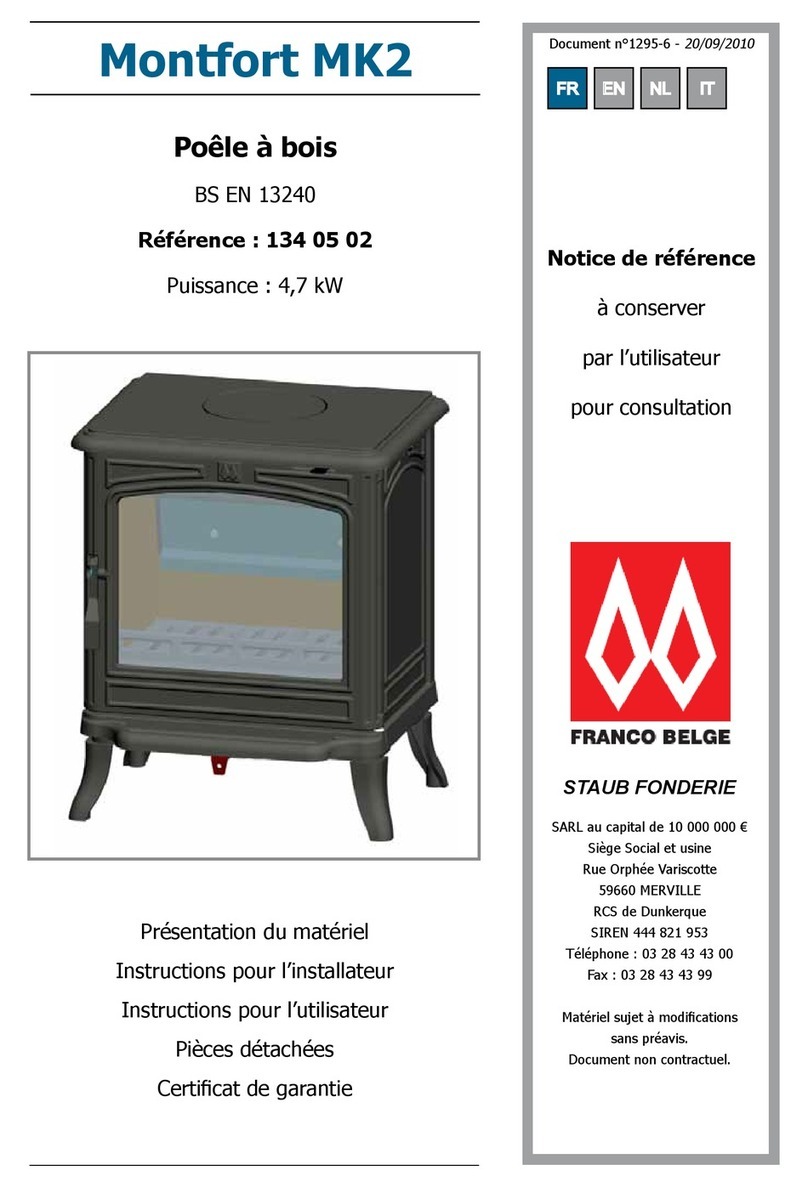
FRANCO BELGE
FRANCO BELGE 134 05 02 Technical manual
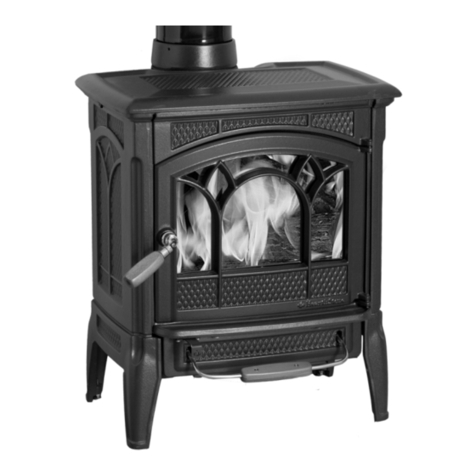
HearthStone
HearthStone 8390 owner's manual

England's Stove Works
England's Stove Works 50-SNC13 Installation & operation manual
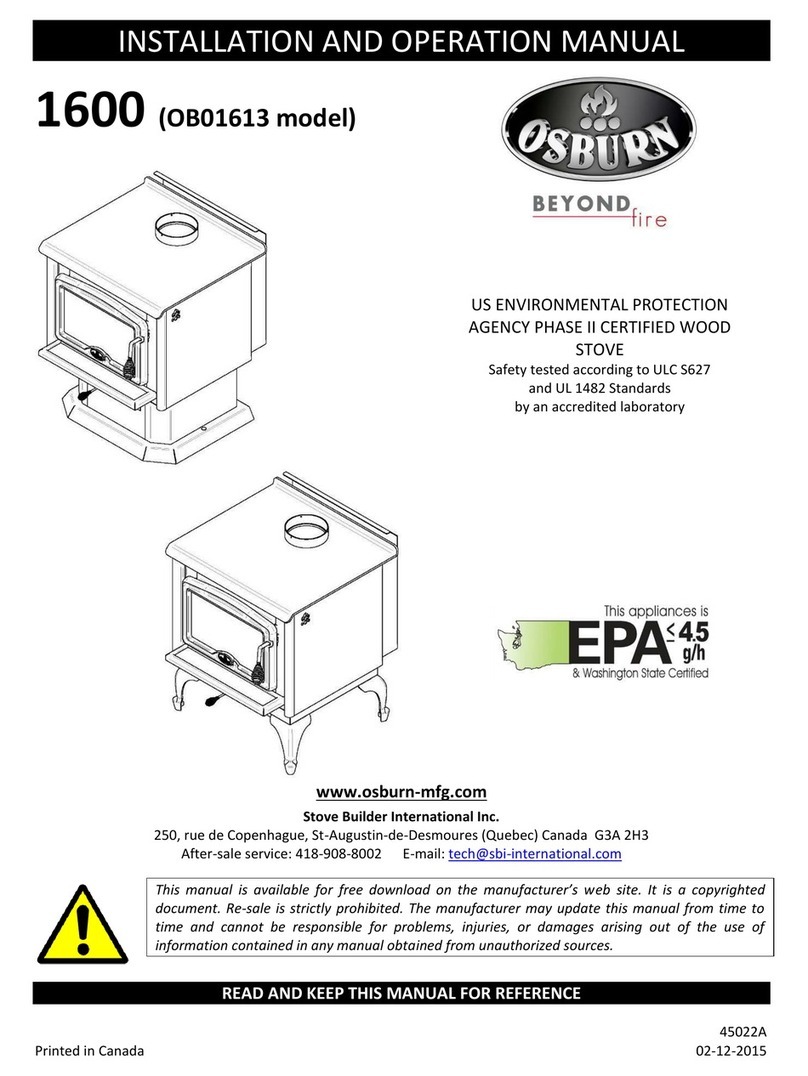
Osburn
Osburn 1600 OB01613 Installation and operation manual
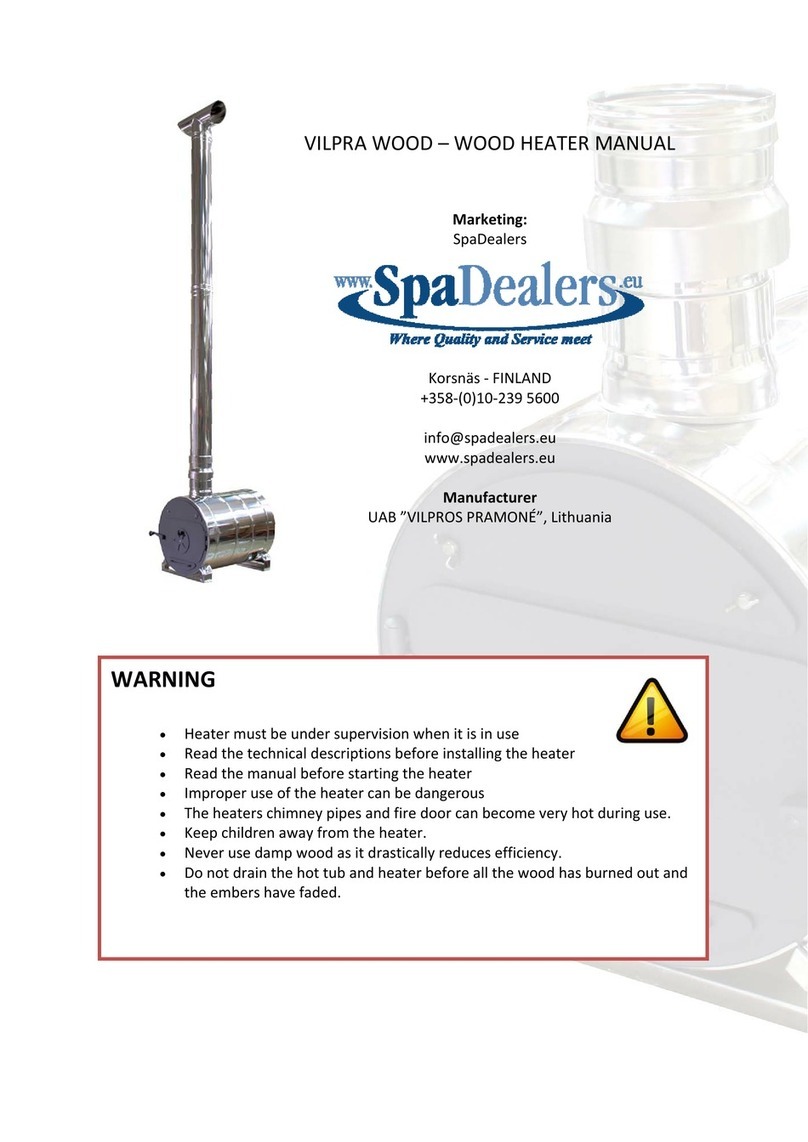
Vilpra Sauna
Vilpra Sauna VILPRA WOOD manual
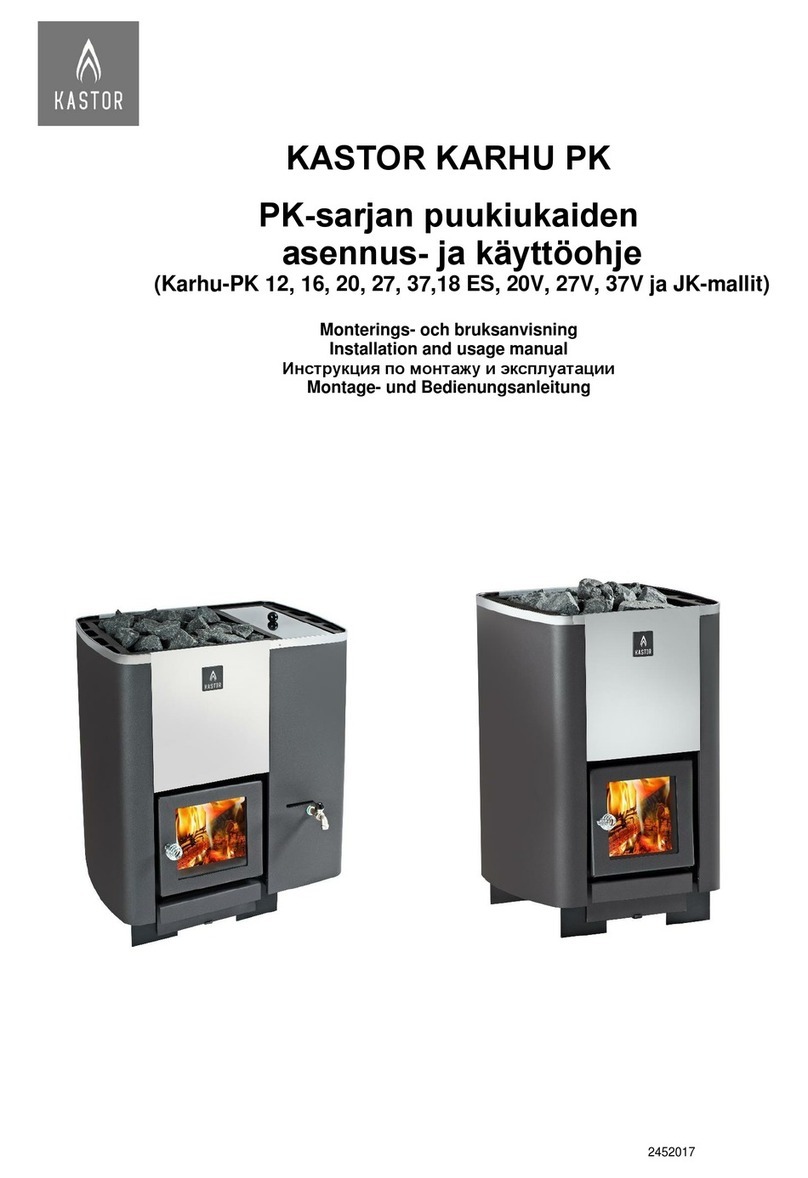
KASTOR
KASTOR KARHU-12PK Installation and usage manual


